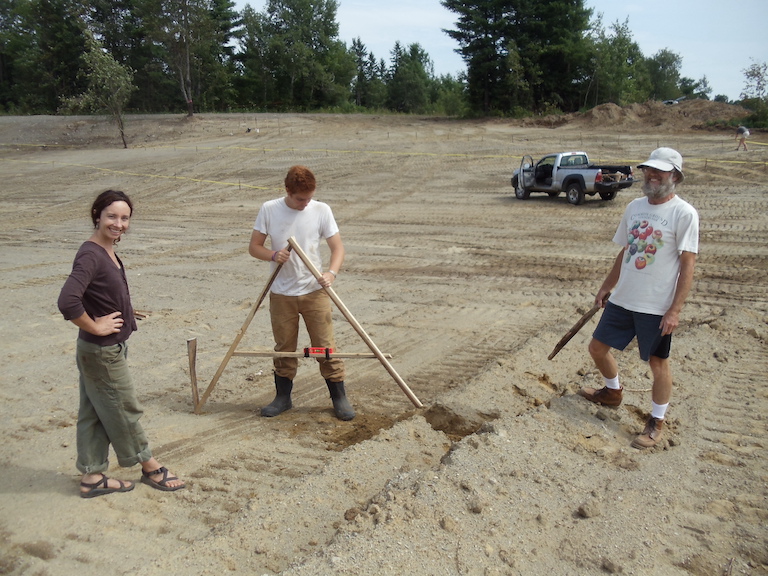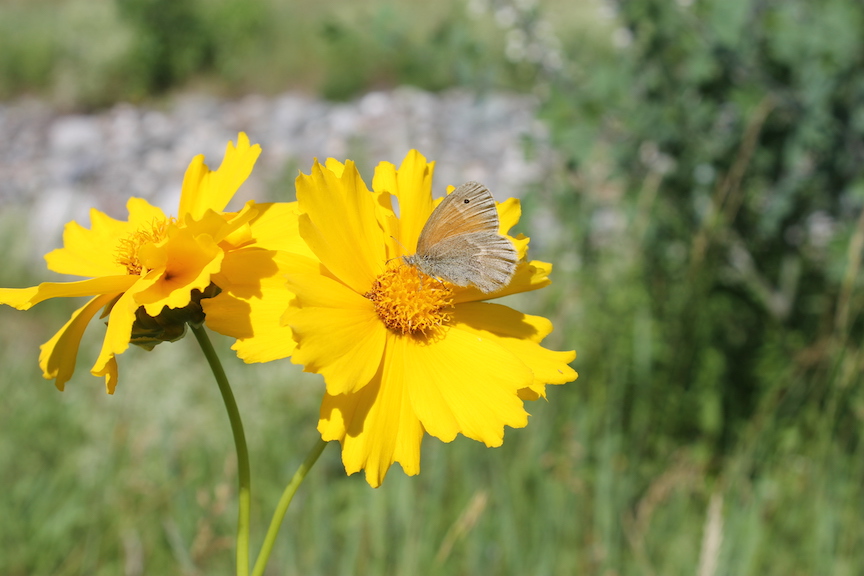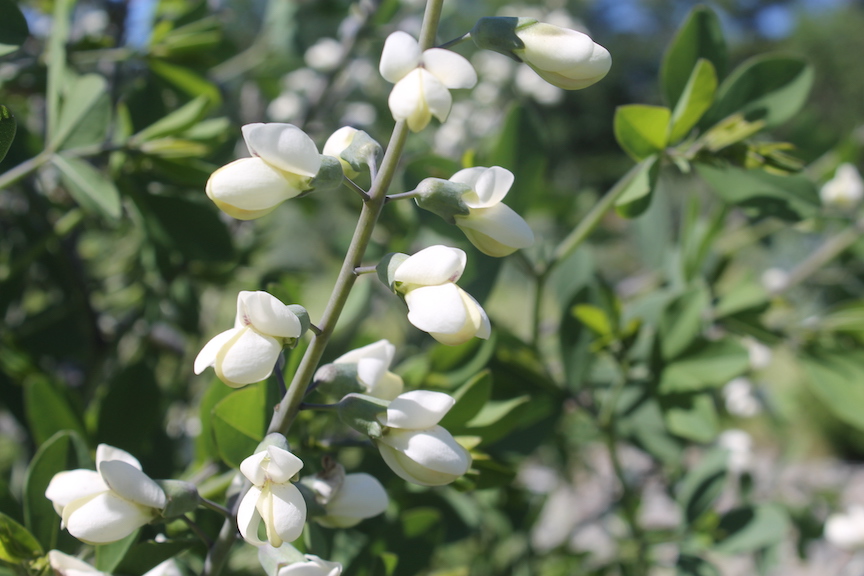By Lauren Cormier
I was one of many volunteers at the first tree planting day in the Maine Heritage Orchard eight years ago in the spring of 2014. Then, hardly a plant was in sight within the precipitous gravel pit that descended sharply to a pond. It had recently been terraced and regraded when we planted the first apple trees just inside the main entrance to coax the gravel pit into becoming an orchard. Erosion on the steepest slopes was imminent and seemingly unstoppable due to the bare ground. The soil was a mixture of sand and clay, lacking topsoil or fertility. I remember thinking, “If a seed does germinate, will it be able to send roots into the hard ground? Is this hillside going to turn into a giant mudslide and erode into the pond? Will apple trees even survive here?” In the photographs from the first year, it looks like we were creating orchard rows with A-frames out in the desert. Now the terraces are mostly covered in vegetation with sandy patches only here and there. This season I’ve been working part-time in the orchard and it’s fascinating to see how the understory has transformed from bare ground to lush vegetation since the early days, both from intentional plantings and from nature’s reclamation.

A few of the perennials from the 2014 planting that have really taken hold and established in the sandy, infertile soil are lance-leaved coreopsis (Coreopsis lanceolata), oxeye sunflower (Heliopsis helianthoides) and stiff goldenrod (Solidago rigida). Julie and Pete Beckford of Rebel Hill Nursery in Liberty provided over two dozen species of native perennials that year. Now, many of these plants have expanded en masse on the terraces. They were chosen for their adaptability to drought conditions and full sun. Among the early plantings were five different species of goldenrod (Solidago spp.) and a variety of perennial sunflowers (Helianthus spp.). A striking white false indigo (Baptisia leucantha), much less common than blue false indigo (Baptisia australis), stands upright at the edge of a terrace and fixes nitrogen into the surrounding soil. Sundial lupine (Lupinus perennis), Black-eyed Susan (Rudbeckia hirta) and various species of aster (Symphyotrichum spp.) are scattered throughout the terraces, too. In planting a diversity of native plants, the goal was to create pollen sources for bees from April through late fall as well as to attract beneficial insects to help keep down insect pests. There have been few cultivars or exotics introduced to the orchard, instead mostly everyday wildflowers frequently seen growing in fields around Maine. We even introduced common milkweed (Asclepias syriaca) so there would be food for monarch butterflies.

The lightly wooded boundaries of the orchard have been particularly valuable to serve as seed banks of native plants. This important habitat to birds, insects and other wildlife, which was disturbed during the earthwork, has regenerated and serves as tiny pockets of wilderness. One of the orchard crew’s favorite wooded areas exists on the southern boundary where there is a young stand of quaking aspen (Populus tremuloides), speckled alder (Alnus incana ssp. rugosa) and beaked hazelnut (Corylus cornuta).

This past spring, we planted 15 American hazelnut (Corylus americana) seedlings so they would be nestled into this edge, bordering the orchard. The hazelnuts should benefit from a woodsy soil composition and have more protection from wind than the more exposed central plants of the orchard. Not too far from the hazelnuts, we also planted a couple dozen New Jersey tea seedlings (Ceanothus americanus) and a patch of wild bergamot (Monarda fistulosa) for pollinators.
It’s exciting to finally see a few native species which moved into the orchard on their own, including red trillium (Trillium erectum) growing under the Fletcher Sweet apple tree and Solomon’s Seal (Polygonatum biflorum) thriving in the shade of an elderberry. Blue-eyed grass (Sisyrinchium montanum) — which is not a true grass despite its name — is mixed in with native grasses, bluets (Houstonia caerulea) and violets (Viola spp). From a thick carpet that has formed over part of the orchard floor, we’ve been harvesting horsetail (Equisetum arvense) for the mineral-rich silica content it provides in plant teas used in weekly foliar sprays. While horsetail is considered a weed in many locations due to toxicity to livestock and its persistent nature, it makes a useful low-spreading ground cover in this orchard.
And last but definitely not least in abundance, some less popular plants have made a home in the orchard, too. Poison ivy (Toxicodendron radicans) has emerged on one of the lower terraces, and we’re smothering it under black plastic while we figure out how to eradicate it. Then there’s fragrant bedstraw (Galium triflorum) with its clouds of billowing white flowers covering large swaths of terrace, outcompeting every plant in its path. We’ve extended a warm welcome to spotted knapweed (Centaurea stoebe) even though it’s considered invasive in many states. It’s been in the orchard from the beginning and has likely been well established in the gravel pit for some time. We can’t help admire its intricate silvery foliage and purple bachelor button flowers, despite the unflattering reputation that comes along with its beauty.
The understory will continue to evolve and diversify as nature regenerates the land with her own successions of species alongside our supplemental companion plantings. Species diversification helps provide ecological balance in the anthropocentric endeavor to grow and preserve rare fruit varieties. The resulting symbiosis of orchard and understory has transformed a small gravel pit in Maine into a dynamic habitat for growing fruit trees and hosting wildlife. As the apple and pear plantings continue to expand on the other side of the pond, the understory will continue to unfold and progress. We’re in the beginning stages of amending dense clay and seeding in cover crops for building up organic matter in the orchard lowlands. We’ll keep you posted!
Lauren Cormier is an orchard assistant in the Maine Heritage Orchard. She lives in Palermo, Maine, where she grows heirloom fruit varieties and nursery stock.
This article was originally published in the fall 2022 issue of The Maine Organic Farmer & Gardener.
